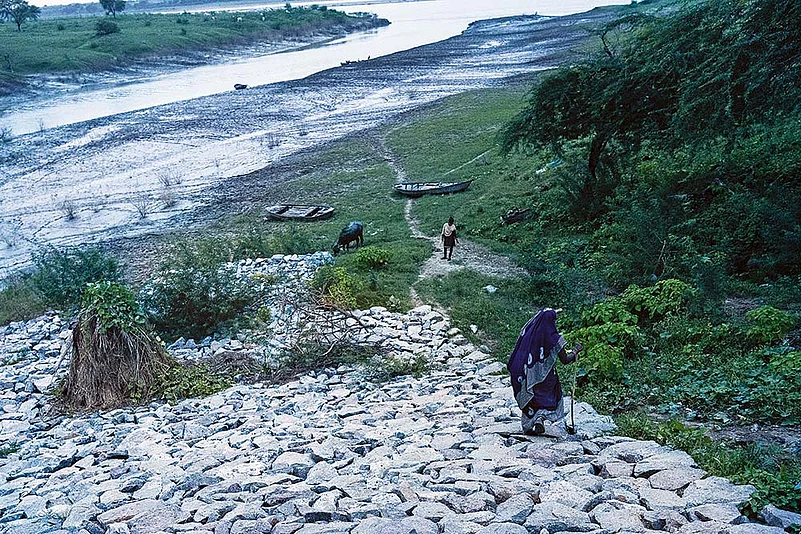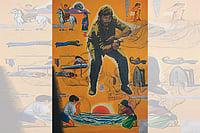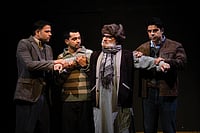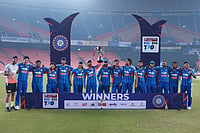This is the cover story for Outlook's 11 September 2024 magazine issue 'Lest We Forget'. To read more stories from the issue, click here
Sheikhpur Gudha looks like a place where the sun has forgotten to rise. Even by the standards of a standard Indian hamlet, it feels gloomy. Buffaloes and goats—hobbling and sauntering from all directions—make the narrow lanes narrower. Neglect marks the battered roads, except buffaloes showering them with shit. Situated on a riverbank, though, the village faces the stirring Noon River, which meets the Yamuna up north, where boats lounge on the shore. A right turn leads you to a house that, over the last four decades, has brought reporters, filmmakers, and authors from all around the world. The villagers are so accustomed to—and yet so fascinated by—the media that a journalist and a camera still animate them. They become tourist guides, make small talk, and tail you. They know why you’re here, and they’ll show you the house.
The most striking thing about it is not the house itself but an elevated room attached to a veranda through two flights of stairs. It’s a mandir, technically, where the visitors take off their shoes before entering. A marble statue of a woman, folding hands, greets them. She is the beti—almost a deity—of this village, who is alive even in death. “The world’s fourth revolutionary woman and an ex-Member of Parliament [MP],” reads a plaque on the wall, “Veerangana Phoolan Devi-ji’s statue was installed on August 10, 2020.”
Phoolan died 23 years ago. Like many survivors of sexual assault, reduced to epithets or hashtags, she too was defined by the most heinous incident in her life. But unlike most, she was much more: a bandit in her teens, a convict in her twenties, an MP in her thirties. Besides the multiple narratives binding her life, she told its different versions to different writers. They produced competing profiles across films, articles, and books—each presenting a different Phoolan. But how do the natives of Sheikhpur Gudha remember her: as a survivor, a baaghi, a leader—or someone else?

“After she died, we lost everything,” says Ram Naresh. “Otherwise, our children’s future would have been much brighter.” Standing beside him, Sumit Nishad adds, “Our society would have developed a lot.” Many villagers—whether young or old, male or female—echo the same regrets. “She wanted to do a lot for the Backward Castes and Dalits, but it was all left undone,” says Ram Bihari. She could have helped us, says Rajyasuri, “but she was killed”. More than 20 years after her death, the people in Phoolan’s hamlet don’t remember her as a survivor or a leader or a bandit. For them, Phoolan is not who she was, but what she could have been. For them, Phoolan is an unfulfilled promise, an unfinished sentence.
“The men are talking nonsense,” says a woman near the riverbank. “When it comes to our safety, nothing has changed.”
But has anything changed here after her death? “Now there’s no gender discrimination,” says her cousin, Indrajeet. “Women are much safer.” Bihari agrees: “Look, every society has unsavoury elements, such as men who drink [and create a ruckus]. But the women here work with men, help them.” Like most men in the village, Shobharan Pehelwan assures me all is well. “It’s not like the old days. Now there’s equality.” He seems more interested in discussing the caste equation though, explaining how Phoolan has inspired the younger educated lot: “She lit a fire: give it back, don’t be scared. Now if the upper-caste fiends try to oppress us, then they’ll be picked from their homes—if they give us the evil eye, their eyes will be gouged.” Now instead of one, adds 107-year-old Devi Dayal, “Hundred will be killed”. He, too, says, “The oppression [of women] has reduced a lot.”
“The men are talking nonsense,” says a woman near the riverbank. “When it comes to our safety, nothing has changed.” The politicians, who praise Phoolan and leave, “use her for political gains”. She is, of course, a towering presence in Sheikhpur Gudha. The villagers celebrate her birthday, mourn her death. She’s on their minds and in their stories and prayers—her photo hangs inside a dilapidated Durga temple. But some perceive her loss more intimately. “When she was alive, we felt protected, but not any longer,” says Pinky. “There were atrocities against us then; there are atrocities against us now.” The status of women in her in-laws’ village, in Etawah district, has also remained unchanged. Pinky doesn’t leave Sheikhpur Gudha in the night alone and, instead, accompanies her father or mother. “I finished school, but my family members didn’t let me attend college because it was far. They were scared.” Many women in the village, she adds, take admission in college but, concerned about their safety, study at home and go to college to just write exams—accompanied by their fathers or brothers.
Like Phoolan’s multiple versions, the issue of women’s safety in her village relays different stories: Yes, it has improved; no, it has not. Or like Pushpa Nishad, a Block Pramukh in the aughts, explains, “Some changes happen; some changes are undone. But now [at least] boys and girls get equal education.” She hasn’t differentiated between her own son and daughter who, unlike her mother, finished school. “My daughter is doing BSc,” says Radha. “And if she wants to work—and if it’s in her kismet and if she has the talent—then I won’t stop her.” Phoolan’s niece, Gangajalee, adds, “Nobody dares to look at the women in a bad way. They’ve become fearless.”

At first, Sheikhpur Gudha cut a different picture from the other Uttar Pradesh hamlets where, reporting during this Lok Sabha election, I met countless diffident women. On my first evening here, though, they seemed confident—some initiating small talk. But the next morning, a complex picture emerged: Many women had covered their faces with veils. Several of them refused to talk to me. Some, when asked about their own lives, spoke about Phoolan. Some couldn’t understand my questions: “You’ve come from a different country. I don’t get your language.” Some said, “What do I tell?” Several young girls hadn’t finished school, refusing to reveal the reason: “Some problem in the family.”
But even when they began to speak, it wasn’t easy to interview them. Because a young, assertive woman disconcerted many men in the village. So they crowded around her, providing answers, interpreting questions, flinging jibes: “What does she know?” Where had I heard that before? In the early ’80s, soon after Phoolan had surrendered, a reporter asked her what she wanted from life. “If I had money,” she replied, “I’d build a house with rooms as large as the hall of this prison. But I know all that is a dream. If any woman had to go through what I went through, then she couldn’t imagine a normal life as well. But what do I know, except cutting grass and using a rifle?”
There’s one thing, though, that finds unambiguous agreement in Sheikhpur Gudha: their relationship with the people of Behmai where, in 1981, Phoolan’s gang killed 20 men. “She only punished those who wronged her,” says Sumit. “Not others.” (Rajyasuri said the same thing.) “A boy from Behmai worked nearby,” says Naresh. “He used to come to my house to eat fish.” Such sentiments pervade the whole village: “Now it’s all good with Thakurs”, “We visit them for marriages and functions”, “Our relations are good, steeped in equality”.
Behmai, around 50 km away, is as small as Sheikhpur Gudha. On the evening of August 24, grey clouds hung over it and, soon, rain drenched the hamlet. It has wide roads, big houses, glistening trees—and, like Phoolan’s village, a mandir-like memorial. Inside, a white plaque lists 20 names. “Martyrs’ Memorial,” reads the text on the top. “On February 14, 1981, at 4 pm, the dacoits massacred the following innocent villagers.” From the ceiling hangs a big rusty bell fastened with a lock as if protecting their last vestiges of honour.
The village is deserted, but I approach a middle-aged man standing outside his house. Babuji seems amiable, but the moment I mention the massacre, whose judgement came earlier this year, and ask about their relationship with the people of Sheikhpur Gudha, his face falls. A brusque reply: “We’ve nothing to do with them.”
A bare-chested man storms out of the house: “What’s the use of asking these questions?” Let it be, says Babuji. “No, why should I? Our condition hasn’t improved one bit. What should I tell you—you tell me?” I try to respond, but he interrupts me. “Every year, at least 20 to 50 reporters come. If you’re tortured, again and again, what will you say? Not one person of Phoolan’s caste lives here, so how can we’ve any relationship with them?” But the people of Sheikhpur Gudha spoke about the improved ties between the two villages and—“They’ll say anything to defend themselves, why should we care? No Thakur lives there, so how can we’ve anything to do with them?” As the birds start to shriek, making the same eerie sound as they did in Sheikhpur Gudha, the man leaves.
“After phoolan died, we lost everything,” says Ram Naresh. “Otherwise, our children’s future would have been much brighter.”
The village is no longer deserted. The scalding monologue has brought many outside their homes, some standing near a shop. “The main matter is,” says Gandhi Singh, “everyone knows what the truth is, but something else has come out.” Like what? “Phoolan Devi wasn’t gang-raped.” He says that, like many, even he was doubtful, so he cross-checked with a famous bandit, “Seema”, who moved in the same circles. “I asked her, ‘Did they come to Behmai after killing Vikram Mallah?’ She said no. Also, this village doesn’t have one person from Phoolan’s caste, so why will we go there to attend marriages?” As Gandhi explains his version of events, Sheikhpur Gudha and Behmai feel like two different worlds. But a sight unites them in a flash: a woman walking on the road—her face covered with a veil.
It’s not just Singh who denies Phoolan’s sexual assault. Many hold the same beliefs, even if their stories differ. Coping with trauma, Behmai has slunk inwards, shutting the door on the world, becoming a world unto itself, where loss, grievances, and memories are not individual but collective. “We had a lot of land and money—a tjiori,” says Jeetendra Singh. “But the dacoits took it all.” He grew up hearing about his uncle, Lal Singh, getting shot by Phoolan’s gang. “She had nothing to do with Behmai. She clashed with a gang in Damanpur [10 km away] and felt humiliated.” But why would she come here then? “No one knows why. That’s what even I wonder.”
Soon his friend, Anuj, joins the conversation. He describes their hardships: growing up in an undeveloped village, where they had no access to electricity or an intermediate school—no hope for the future. “Her gang weighed and stole 5 kg of gold and silver,” says Jeetendra. “We were disrespected in our own village.” Behmai has gone quieter and darker, except for the shrieking of birds, which continues to intensify. “If we’d have got that money from our ancestors, we’d have been something else,” says Anuj. “We wouldn’t be drivers.” The conversation runs around in circles—doused in disappointment, victimhood, and self-pity—and then, Jeetendra asks me a question: “Have you seen a bigger injustice than this?”
The two villages are not 50 km away but worlds apart. Yet they’re more similar than different: a memorial there, a memorial here; an injustice there, an injustice here; a truth there, a truth here. There’s no one story anywhere; there are stories—and stories within stories. As if the Rashomon effect has come to life with just one resounding truth: women wearing veils.
In Sheikhpur Gudha, the caste issue had coalesced into a unified story—the villagers not just spoke about “giving it back to the Thakurs” but also sounded comfortable about their identities (they’d say their names, then add with confidence, “Nishad”)—but not patriarchy. Because the interrupting, mocking bros made me believe that not much had changed, that Phoolan was just a gun-toting aberration.
One afternoon, a man named Chandrashekhar Nishad tailed me in the village. I was more interested in the experiences of women, so I ignored him, but he kept following me. At one point, unasked, he spoke about his children—a son and two daughters, aged two and seven. “I’ve no hopes for myself, but I can only hope for them. I want them to eat, dress, and study well, so that the society respects them.” What does he want his daughter to be? “I can’t say whether I want her to be a doctor, engineer, or teacher. My duty is to just pay for her education: She’ll become who she wants to be.”
On my first day in Sheikhpur Gudha, I had seen a young girl, around the same age as his daughter, drawing water from a tube well. I asked her name. “Srishti,” she said, with a bounce in her voice. Which class are you in? “Two, three, arre, four.” Do you know where Phoolan Devi’s house is? Yes, she nodded, the house right after. Do you know anything about her? A big pause, then a shy smile: “No.” What do you want to be when you grow up? “Police.”
It didn’t sound like a throwaway remark because, over the last decade, at least three women have joined the force—the first in the history of this village. Darshan Lal’s daughter, Poonam, is one of them. Studying in a local school, she did “mehnat-majdoori [hard labour]” with her father. His younger daughter worked the fields of a man, “Master Sahab”, who had opened a “local inter college”. One day, he asked her professional plans. She came home and told Lal, “Dada, I’m in high school, but didi is doing inter.” Lal met the teacher who told him, “The forms have come out. Tell her to fill one.” Poonam wrote the exam in 2013 and joined the police three years later. “He supported and helped us a lot,” says Lal. In Sheikhpur Gudha, it (literally) took a village to raise a child.
Ashok Kumar’s daughter, also named Poonam, wanted to be a cop. She got married in 2017, when her in-laws had no problem with her ambition, but then, “Ladka palat gaya [the guy refused].” His family wanted her to stay home, cook, work the fields. Her husband was a “suspicious type”, says Kumar, objecting to Poonam interacting with her male colleagues. “But we fought.” Kumar approached the cops who, along with him, berated the husband: “If bitiya wants to work, she will work.” Poonam got her wish. She earns a living; her husband doesn’t—she’s the family’s breadwinner, the ‘man’ of the house.
MORE FROM THIS ISSUE
Many villagers know the stories—and struggles—of both the Poonams, relaying their achievements with understated pride. Standing near Srishti, another young girl, Tejal, had caught my attention. Two ponytails hung from her head, and she wore a kajal so big that it touched her upper cheek. How old are you? “I don’t know. I’ll have to ask my mother.” Do you go to school? “Yes, class three.” What do you like studying the most? “The names of fruits.” What would you like to be? “Army.” She darts away; her left arm cutting rapid circles. A few seconds later, she stops, turns around, and smiles, and then, continues to run.
(This appeared in the print as 'Songlines of Chambal')

































